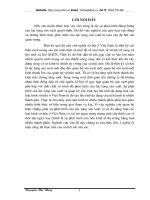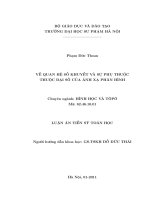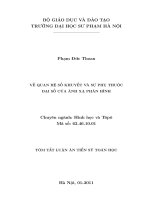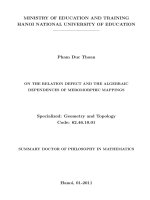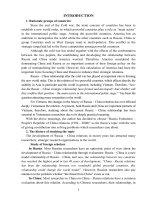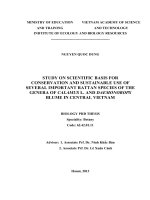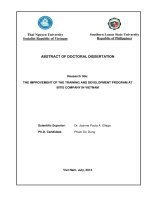Về quan hệ số khuyết và sự phụ thuộc của ánh xạ phân hình bản tóm tắt tiếng anh
Bạn đang xem bản rút gọn của tài liệu. Xem và tải ngay bản đầy đủ của tài liệu tại đây (153.62 KB, 27 trang )
MINISTRY OF EDUCATION AND TRAINING
HANOI NATIONAL UNIVERSITY OF EDUCATION
—————————–
Pham Duc Thoan
ON THE RELATION DEFECT AND THE ALGEBRAIC
DEPENDENCES OF MEROMORPHIC MAPPINGS
Specialized: Geometry and Topology
Code: 62.46.10.01
SUMMARY DOCTOR OF PHILOSOPHY IN MATHEMATICS
Hanoi, 01-2011
2
Thesis was completed at: Hanoi national University of Education
Science instructor: Prof. Dr. Do Duc Thai
Rewier 1: Prof. Dr. Nguyen Van Mau, Hanoi University of Science-
Vietnam National University
Rewier 2: Prof. Dr. Le Hung Son, Hanoi University of Technology.
Rewier 3: Prof. Dr. Nguyen Van Khue, Hanoi National University
of Education.
Thesis will be approved by School committee at
hour date month year
Thesis can be found at: -Viet Nam national library
-Library of Hanoi National University of
Education
1
Introduction
1. Reasons for selecting topics
In the late 20’s last century, Nevanlinna foundated the value
distribution theory of the meromorphic function of a variable. Over
the next decade many mathematicians in the world such as H.
Cartan, W. Stoll, PA Griffiths, L. Carlson, P. Vojta, J. Noguchi
interest in research and develop on Nevanlinna theory for more
general object class. So far, Nevanlinna theory has become one
of the most important theory of mathematics with many beautiful
theorems have been proved. The most striking result is that the
inequality in terms of defects and unicity theorem. By the attractive
nature of the geometric theory, we have chosen the theme ”On
the relation defect and the algebraic dependences of
meromorphic mappings”. Specifically, we focus on research and
has given some results on the defects for meromorphic functions to
P
1
(C) and meromorphic mappings to P
n
(C), and we also study the
algebraic dependences and apply these results to the study unicity
problem with truncated multiplicity for meromorphic mappings of
several complex variables.
2. The aim and subject of thesis
The main aim of the thesis is to study the meromorphic having
maximal defect sum and the algebraic dependence of the meromor-
phic mappings.
Stadying subject is the meromorphic mappings with a maximum
with maximal defect sum and the algebraic dependence of the
meromorphic mappings.
2
3. Studying methods used in thesis
Using knowledges about Complex Geomatry and Complex Anal-
ysis, Nevanlinna theory. Simultaneously, we also created new tech-
niques to solve the issues raised in the thesis. The first is the study
of the maximal defect sum of the meromorphic function, we have
devised a ”noise” by ”small” function. The second is the study of
unique problems of meromorphic mapping, the authors often proved
directly and through the second fundamental theorem. Here, we ap-
proach the problem with the theory of ”algebraic dependence” of the
meromorphic mappings of several complex variables that W. Stoll
proposed.
4. The results of the thesis
Among the theorems that Nevanlinna proved, the theorem about
the relationship of defect to keep a special role. Namely, the theorem
is stated the following:
Theorem A. If f be a nonconstant meromorphic function on
C then
a∈P
1
(C)
δ(a, f) 2.
Theorem A was proved for the class meromorphic functions of
complex variables. For example, theorem Cartan-Nochka said that
if f : C → P
n
(C) be a linearly nondependence holomorphic function
and {H
j
}
q−1
j=0
be hyperplanes in N-subgeneral position in P
n
(C)
then
q−1
i=0
δ
[n]
(H
i
, f) ≤ 2N − n + 1. Have a question naturally
arises: What we can say about the class of functions f which is
the maximal defect sum? In other words, we can say about the
equal sign in inequality occurring defects? This problem were many
mathematicians research interest in recent times. For example, N.
3
Toda proved the following theorem:
Theorem B. Let f : C
m
−→ P
n
(C) be a linearly nondegenerate,
and let {H
j
}
q
j=1
be hyperplanes in N-subgeneral position in
P
n
(C), where 1 ≤ n < N and 2N − n + 1 < q ≤ +∞. Assume
that δ(H
j
, f) > 0 (1 ≤ j ≤ q) and
q
j=1
δ
[n]
(H
j
, f) = 2N − n + 1.
Then one of the following two statements holds:
(I) There are at least
2N − n + 1
n + 1
+ 1 of the hyperplanes H
j
at which f has deficiency value 1, i.e δ(H
j
, f) = 1,
(II) {H
j
}
q
j=1
has a Borel distribution.
Continue the above research , in the first two chapters of the thesis
we study the class meromorphic mappings which has a maximal de-
fect sum. Namely, in Chapter 1 we showed the necessary condition
for the class meromorphic function has a maximal defect function,
also indicate that the meromorphic function is very small. Specifi-
cally, we have proved the following two theorems.
Theorem 1.3.1. Let f : C → P
1
(C) be a meromorphic function
of finite order. For each n ≥ 1, define g
n
(z) = f(z
n
), ∀z ∈ C and
h
n
(z) = f
n
(z), ∀z ∈ C. Then we have necessarily λ := ρ
f
∈ Z
+
and λ equals the lower order of f
1) If there exists n
0
≥ 2 such that
a∈C
δ(a, g
n
0
) = 2.
2) If there exists a sequence {n
i
}
+∞
i=1
⊂ Z
+
such that
a∈C
δ(a, h
n
i
) =
2, ∀i ≥ 1.
4
Theorem 1.3.2. Let f : C
m
→ P
1
(C) be a meromorphic func-
tion of finite order satisfying
λ := ρ
f
/∈ Z and
a∈C
δ(a, f) = 2.
Denote by A the set of all nonconstant meromorphic functions
h : C
m
→ P
1
(C) such that T
h
(r) = o
T
f
(r)
, T
D
h
(r) = o
T
D
f
(r)
.
Then, for each h ∈ A, we have
a∈C
δ(a, f + h) 2 − 2k(λ) < 2,
where k(λ) is a positive constant which depends only on λ.
Chapter 2 of the thesis has extended the results of N. Toda for
class meromorphic mappings of several variables that have maximal
defect sum for moving targets. Namely, we have proved the following
theorem.
Theorem 2.3.1. Let f : C
m
−→ P
n
(C) be a nonconstant
meromorphic mapping, and let {a
i
}
q−1
i=0
be ”small” (with respect
to f) meromorphic mappings of C
m
into P
n
(C) in N− subgeneral
position such that f is linearly nondegenerate over R({a
i
}
q−1
i=0
),
where 1 ≤ n < N and 2N − n + 1 < q < +∞. Suppose further
that f has nonzero deficiency value at a
i
for each 0 ≤ i ≤ q − 1
and
q−1
j=0
δ (a
j
, f) = 2N − n + 1.
Then one of the following two statements holds.
(I) There are at least [
2N − n + 1
n + 1
] + 1 of the moving targets a
j
at which f has deficiency value 1, i.e δ(a
j
, f) = 1 ,
(II) n is odd and the family {a
j
}
q−1
j=0
has a Borel distribution.
In 1926, Nevanlinna proved that if f and g be two non-constant
meromorphic functions on C such that f
−1
(a
i
) = g
−1
(a
i
) at 5
5
distinction point a
1
, · · · , a
5
then f ≡ g. In the context of the review
theorem 5 point of Nevanlinna for meromorphic function of several
complex variables into complex projective space, in 1975 H. Fujimoto
proved the following important theorem.
Theorem C. Let H
i
(1 ≤ i ≤ 3N + 2) be 3N + 2 hyperplanes
in general position in P
N
(C), f and g be two non-constant
meromorphic mappings from C
n
to P
N
(C) such that f(C
n
)
H
i
, g(C
n
) H
i
. Assume that v
(f,H
i
)
= v
(g,H
i
)
with 1 ≤ i ≤ 3N +2.
Then, if f or g be linearly nondependence then f ≡ g.
In the last decade many works have continued to develop on the
results of H. Fujimoto and has formed a research direction in the
Nevanlinna theory is the study problem unicity (also known as the
unicity theorem.) In particular, the unicity theorem has been studied
continuously in recent years and has obtained deep results. Among
the approaches to the unicity problem has a method by W. Stoll
proposed, research unicity problem that is through study of the al-
gebraic dependence of meromorphic mappings. Development of the
above ideas of W. Stoll, in 2001 M.Ru showed unicity theorem for
holomorphic curves into complex projective space with moving tar-
gets. Namely, M. Ru proved the following:
Theorem D. Let f and g be non-constant meromorphic func-
tions. if there exists 7 distinction meromorphic functions
a
1
, a
2
, · · · , a
7
such that T
a
j
(r) = o(max{T
f
(r), T
g
(r)}) (0 ≤ j ≤
7) and f(z) = a
j
(z) ⇔ g(z) = a
j
(z) then f ≡ g.
Continue the above research , in the chapters 3 of the thesis, we
have showed some unicity theorem for meromorphic mappings of
several variables to complex projective space through the study of
6
the algebraic dependence of their mapping. The results that we
achieved a significant expansion for the theorems of M. Ru. Namely,
we proved the following theorem:
Theorem 3.2.4. Let f
1
, · · · , f
λ
: C
m
→ P
n
(C) be nonconstant
meromorphic mappings. Let g
i
: C
m
→ P
n
(C) (1 ≤ i ≤ q) be
moving targets located in general position such that T(r, g
i
) =
o(max
1≤j≤λ
T (r, f
j
)) (1 ≤ i ≤ q) and (f
i
, g
j
) ≡ 0 for 1 ≤
i ≤ λ, 1 ≤ j ≤ q. Let κ be a positive integer or κ = +∞
and κ = min{κ, n}. Assume that the following conditions are
satisfied.
i) min{κ, v
(f
1
,g
j
)
} = · · · = min{κ, v
(f
λ
,g
j
)
} for each 1 ≤ j ≤ q,
ii) dim{z|(f
1
, g
i
)(z) = (f
1
, g
j
)(z) = 0} ≤ m − 2 for each
1 ≤ i < j ≤ q,
iii) There exists an integer number l, 2 ≤ l ≤ λ, such that for
any increasing sequence 1 ≤ j
1
< · · · < j
l
≤ λ, f
j
1
(z) ∧ · · · ∧
f
j
l
(z) = 0 for every point z ∈ ∪
q
i=1
(f
1
, g
i
)
−1
{0}.
Then
i) If q >
n(2n + 1)λ − (
κ − 1)(λ − 1)
λ − l + 1
, then f
1
, · · · , f
λ
are
algebraically dependent over C, i.e. f
1
∧ · · · ∧ f
λ
≡ 0 on C
m
.
ii) If f
i
, 1 ≤ i ≤ λ are linearly nondegenerate over R
{g
j
}
q
j=1
and
q >
n(n + 2)λ − (κ − 1)(λ − 1)
λ − l + 1
,
then f
1
, · · · , f
λ
are algebraically dependent over C.
iii) If f
i
, 1 ≤ i ≤ λ are linearly nondegenerate over C, g
i
(1 ≤
i ≤ q) are constant mappings and (q − n − 1)((λ − 1)(κ − 1) +
q(λ − l + 1)) ≤ qnλ, then f
1
, · · · , f
λ
are algebraically dependent
7
over C
m
.
Theorem 3.3.1 Let f
1
, f
2
: C
m
→ P
n
(C) be non-constant mero-
morphic mappings. Let g
j
: C
m
→ P
n
(C) be moving targets lo-
cated in general position and T (r, g
j
) = o(max
1≤i≤2
{T (r, f
i
)}), 1 ≤
j ≤ q and (f
i
, g
j
) ≡ 0 for 1 ≤ i ≤ 2, 1 ≤ j ≤ q. Let κ be a pos-
itive integer or κ = +∞ and κ = min{κ, n}. Assume that the
following conditions are satisfied.
i) min{κ, v
(f
1
,g
j
)
(z)} = min{κ, v
(f
2
,g
j
)
} for each z ∈ C
m
and
1 ≤ j ≤ q
ii) dim{(f
1
, g
i
)
−1
{0} ∩ (f
1
, g
j
)
−1
(z)} ≤ n − 2 for each 1 ≤ i <
j ≤ q
iii) f
1
(z) = f
2
(z) for each z ∈ ∪
q
j=1
(f
1
, g
j
)
−1
{0}.
If q > 2n(2n + 1) − 2(κ − 1) then f
1
≡ f
2
.
5. Structure of the thesis
The layout of the thesis out of the introduction and the conclusion,
the thesis consists of three chapters.
Chapter I: ”On meromorphic functions with maximal
defect sum”.
Chapter II: ”Meromorphic mappings with maximal de-
fect sum for moving targets”.
Chapter III: ”The algebraic dependence of the meromor-
phic mappings and applications”.
8
Chapter 1
On meromorphic functions with maximal
defect sum
we show the necessary conditions of the maximality of defect sum
and show that the class of meromorphic functions with maximal
defect sum is very thin in the sense that deformations of meromorphic
functions with maximal defect sum by small meromorphic functions
are not meromorphic functions with maximal defect sum. This
chapter is based on the article [4].
Theorem of classical Nevanlinna deficiency relation was pointed
out that if f : C
m
−→ P
1
(C) be a meromorphic function then
a∈P
1
(C)
δ(a, f) 2.
A question naturally arises: What can be said about the class of
meromorphic functions f is
a∈P
1
(C)
δ(a, f) = 2? This problem has
research interests of many mathematicians, such as N. Toda, J. Lu
and Y. Yasheng
As stated in the introduction, the purpose of this chapter is to
continue to study the problem on the meromorphic function of
the fixed target. Namely, we show the necessary conditions of
the maximality of defect sum. Later, we show that the class of
meromorphic functions with maximal defect sum is very thin in
the sense that deformations of meromorphic functions with maximal
defect sum by small meromorphic functions are not meromorphic
functions with maximal defect sum. Further more, we can measure
the deviation of defect sum of meromorphic functions before and
after by constant.
9
1.2 Some initial results
The purpose of this section is to prove the Lemmas prepare for two
of the first main result of the thesis
Lemma 1.2.3. Let f, g : C
m
→ P
1
(C) be nonconstant
meromorphic functions of finite order. Assume that ρ
f
= λ, ρ
g
=
λ
and λ > λ
. Then
(i) ρ
(f+g)
= λ.
(ii) ρ
f·g
= λ.
Lemma 1.2.4. Let f : C
m
→ P
1
(C) be a nonconstant
meromorphic function of finite order. Then, T
D
f
(r) 2T
f
(r) +
O(log rT
f
(r)) and hence, ρ
D
f
ρ
f
.
Lemma 1.2.5.
Let f : C
m
→ P
1
(C) be a nonconstant meromorphic function.
Define g = f
n
, where n ∈ Z
+
and h = f + a with a ∈ C. Then
ρ
g
= ρ
f
, ρ
h
= ρ
f
and ρ
1
f
= ρ
f
.
Lemma 1.2.6. The following mappings do not change the
defect sum
α : f →
1
f
v β
a
: f → f + a, ∀a ∈ C.
Lemma 1.2.7. Let f, g : C
m
→ P
1
(C) be nonconstant mero-
morphic functions of finite order. Then, one of the following
two assertions holds:
(i) ρ
D
f
= ρ
f
.
(ii) ρ
D
1
f
= ρ
1
f
.
Lemma 1.2.10. Let f : C
m
→ P
1
(C) be a nonconstant
10
meromorphic function such that δ(∞, f) = 0. Then
a∈C
δ(a, f) =
a∈C
δ(a, f) 2δ(0, D
f
).
By the same argument in Lemma 1.2.3, we have the following:
Lemma 1.2.11. Let f, g : C
m
→ P
1
(C) be nonconstant
meromorphic functions of finite order satisfying ρ
f
= λ and
T
g
(r) = o
T
f
(r)
. Then
(i) ρ
f+g
= λ.
(ii) ρ
f.g
= λ.
Lemma 1.2.12. Let f, h : C
m
→ P
1
(C) be nonconstant
meromorphic functions satisfying δ(∞, f) = 0 and T
h
(r) =
o
T
f
(r)
. Put g = f + h. Then δ(∞, g) = 0.
Lemma 1.2.14. Let f : C
m
→ P
1
(C) be a nonconstant
meromorphic function. Define g = f
n
, where n ∈ Z
+
. Then
T
D
g
(r)
n+1
n
T
g
(r) + O(log rT
f
(r)).
Lemma 1.2.15. Let f : C
m
→ P
1
(C) be a nonconstant
meromorphic function of finite order. Then, there exists a
meromorphic function f
1
: C
m
→ P
1
(C) of finite order such
that
a∈C
δ(a, f
1
) =
a∈C
δ(a, f) and
ρ
f
1
= ρ
D
f
1
δ(∞, f
1
) = 0
1.3 On meromorphic functions with maximal defect
sum
The purpose of this chapter is to prove the following two results:
Theorem 1.3.1. Let f : C → P
1
(C) be a meromorphic function
of finite order. For each n ≥ 1, define g
n
(z) = f(z
n
), ∀z ∈ C and
11
h
n
(z) = f
n
(z), ∀z ∈ C. Then we have necessarily λ := ρ
f
∈ Z
+
and λ equals the lower order of f
1) If there exists n
0
≥ 2 such that
a∈C
δ(a, g
n
0
) = 2.
2) If there exists a sequence {n
i
}
+∞
i=1
⊂ Z
+
such that
a∈C
δ(a, h
n
i
) =
2, ∀i ≥ 1.
Theorem 1.3.2. Let f : C
m
→ P
1
(C) be a meromorphic func-
tion of finite order satisfying
λ := ρ
f
/∈ Z and
a∈C
δ(a, f) = 2.
Denote by A the set of all nonconstant meromorphic functions
h : C
m
→ P
1
(C) such that
T
h
(r) = o
T
f
(r)
, T
D
h
(r) = o
T
D
f
(r)
.
Then, for each h ∈ A, we have
a∈C
δ(a, f +h) 2−2k(λ) < 2,
where k(λ) is a positive constant which depends only on λ.
12
Chapter 2
Meromorphic mapping with maximal with
defect sum for moving targets
This chapter is based on the article [3]. The chapter for the study of
the meromorphic mappings from C
m
to P
n
(C) with maximal defect
sum for moving targets.
For about 20 years, the study of Nevanlinna theory for moving
targets were more interested in mathematics. This is a natural ex-
tension when we replace the hyperplane (or hypersurface) fixed in
the complex projective space with a small coefficient of the function.
One of the most important results of this research is the theorem
Cartan-Nochka for moving targets proved by M. Ru and W. Stoll.
Theorem. Let f : C
m
−→ P
n
(C) be a nonconstant meromor-
phic mapping and assume that {a
i
}
q−1
i=0
be ”small” meromorphic
mappings corresponding to f from C
m
to P
n
(C) in N-subgeneral
position such that f is linearly nondependence on R({a
i
}
q−1
i=0
).
Then
q−1
j=0
δ (a
j
, f) ≤ 2N − n + 1.
Thus there is a question naturally arises:What we can say about the
functions f which is the number of defects for maximal? In other
words, we can extend the results of N. Toda for the meromorphic
mappings of several variables that have maximal defect sum with
moving targets or not? The main purpose of this chapter is to answer
that question.
2.2 The initial results
13
First we recall two of the Nochka weight Lemma for moving targets.
How to prove they are repeated all the claims corresponding to the
fixed hyperplane.
Lemma 2.2.1. Let {a
i
}
i∈Q
be q moving targets in P
n
(C) in N-
subgeneral position, and assume that q > 2N −n+1. Then there
are positive rational constants ω
j
, j ∈ Q satisfying the following:
i) 0 < ω
j
≤ 1, ∀j ∈ Q,
ii) Setting
˜ω = max
j∈Q
ω
j
, one gets
q
j=1
ω
j
=
˜ω(q − 2N + n −
1) + n + 1.
iii)
n + 1
2N − n + 1
≤ ˜ω ≤
n
N
.
iv) For R ⊂ Q with 0 < |R| ≤ N + 1,
j∈R
ω
j
≤ rank{a
i
}
i∈R
.
The above ω
j
are called Nochka weights, and
˜
ω the Nochka constant.
We will denote θ = ˜ω
−1
for later convenience.
Lemma 2.2.2. Let q > 2N − n + 1, and let {a
i
}
i∈Q
be q
moving targets in P
n
C in N-subgeneral position. Let {ω
j
}
j∈Q
be its Nochka weights. Let E
j
≥ 1, j ∈ Q be arbitrarily given
numbers. Then for every subset R ⊂ Q with 0 < |R| ≤ N + 1,
there is a subset R
o
⊂ R such that |R
o
| = rank{a
i
}
i∈R
and
i∈R
E
ω
i
i
≤
i∈R
o
E
i
.
The purpose of this section is to prove lemma plays an important
role in proving the theorem on the deficiency of meromorphic map-
pings with maximal deficiency sum for moving targets.
Lemma 2.2.7. Let f be a meromorphic mapping of C
m
into
P
n
(C) with a reduced representation f = (f
0
: · · · : f
n
). Consider
N > n and q be any integer satisfying 2N −n+1 < q < +∞. Put
14
Q = {0, 1 . . . , q − 1}. Let X = {a
j
: j ∈ Q} be the set of ”small”
(with respect to f) meromorphic mappings from C
m
into P
n
(C)
in N-subgeneral position. Assume that f is nondegenerate over
R({a
i
}
q−1
i=0
) and any function ω : Q → (0, 1] satisfy the condition
(iv) in Lemma 2.2.1, we have
q−1
j=0
ω(j) · δ (a
j
, f) ≤ n + 1.
2.3 The meromorphic mapping with maximal defi-
ciency sum
In this section, we use the above lemmas to prove the theorems
on the deficiency of meromorphic mappings with maximal deficiency
sum for moving targets.
Theorem 2.3.1 Let f : C
m
−→ P
n
(C) be a nonconstant
meromorphic mapping, and let {a
i
}
q−1
i=0
be ”small” (with respect
to f) meromorphic mappings of C
m
into P
n
(C) in N− subgeneral
position such that f is linearly nondegenerate over R({a
i
}
q−1
i=0
),
where 1 ≤ n < N and 2N − n + 1 < q < +∞. Suppose further
that f has nonzero deficiency value at a
i
for each 0 ≤ i ≤ q − 1
and
q−1
j=0
δ (a
j
, f) = 2N − n + 1.
Then one of the following two statements holds.
(I) There are at least [
2N − n + 1
n + 1
] + 1 of the moving targets a
j
at
which f has deficiency value 1, i.e δ(a
j
, f) = 1 ,
(II) n is odd and the family {a
j
}
q−1
j=0
has a Borel distribution.
15
Chapter 3
The algebraic dependences of meromorphic
mappings and applications
This chapter for the study of algebraic dependence of the mero-
morphic mapping from C
m
to P
n
(C) with moving targets in general
position and application to the study of unicity problem. The chapter
is based on the article [1] end [2].
The theory on algebraic dependences of meromorphic mappings
in several complex variables into the complex projective spaces
for fixed targets is studied by W. Stoll in 1989. Later, Min Ru
generalized Stoll’s result to holomorphic curves into the complex
projective spaces for moving targets and show some unicity theorems
of holomorphic curves into the complex projective spaces for moving
targets. As far as we know, they are the first results on the unicity
problem for moving targets. We now state his remarkable results.
Let g
1
, . . . , g
q
(q ≥ n) be q meromorphic mappings of C
m
into
P
n
(C) with reduced representations g
j
= (g
j0
: · · · : g
jn
) (1 ≤
j ≤ q). We say that g
1
, . . . , g
q
are located in general position if
det(g
j
k
l
) ≡ 0 for any 1 ≤ j
0
< j
1
< < j
N
≤ q.
Let M
n
be the field of all meromorphic functions on C
m
. Denote
by R
g
j
q
j=1
⊂ M
n
the smallest subfield which contains C and
all
g
jk
g
jl
with g
jl
≡ 0.
Let f be a meromorphic mapping of C
m
into P
n
(C) with reduced
representation f = (f
0
: · · · : f
n
). We say that f is linearly non-
degenerate over R
g
j
q
j=1
if f
0
, . . . , f
N
are linearly independent
16
over R
g
j
q
j=1
.
Let f
t
: C
m
→ P
n
(C) (1 t λ) be meromorphic mappings
with reduced representations f
t
:= (f
t0
: · · · : f
tn
). Let g
j
: C
m
→
P
n
(C) (1 j q) be moving targets located in general position
with reduced representations g
j
:= (g
j0
: · · · : g
jN
). Assume that
(f
t
, g
j
) :=
N
i=0
f
ti
g
ji
= 0 for each 1 ≤ t ≤ λ, 1 ≤ j ≤ q and
(f
1
, g
j
)
−1
{0} = · · · = (f
λ
, g
j
)
−1
{0}. Put A
j
= (f
1
, g
j
)
−1
{0} for
each 1 j q. Assume that every analytic set A
j
has the irriducible
decomposition as follows A
j
= ∪
t
j
i=1
A
ji
(1 t
j
+∞). Set
A = ∪
A
ji
≡A
kl
{A
ji
∩ A
kl
} with 1 ≤ i ≤ t
j
, 1 ≤ l ≤ t
k
, 1 ≤ j, k ≤ q.
Denote by T [n+1, q] the set of all injective maps from {1, · · · n+1}
to {1, · · · , q}. For each z ∈ C
m
\ {∪
β∈T [n+1,q]
{z|g
β(1)
(z) ∧ · · · ∧
g
β(n+1)
(z) = 0} ∪ A ∪ ∪
λ
i=1
I(f
i
)}, we define ρ(z) = {j|z ∈ A
j
}.
Then ρ(z) ≤ n. For any positive number r > 0, define ρ(r) =
sup{ρ(z)||z| ≤ r}, where the supremum is taken over all z ∈
C
m
\{∪
β∈T [n+1,q]
{z|g
β(1)
(z)∧· · ·∧g
β(n+1)
(z) = 0}∪A∪∪
λ
i=1
I(f
i
)}.
Then ρ(r) is a decreasing function. Let
d := lim
r→+∞
ρ(r).
Then d ≤ n. If for each i = j, dim{A
i
∩ A
j
} ≤ m − 2, then d = 1.
We state the following M. Ru’ theorems
Theorem A. Let f
1
, · · · , f
λ
: C → P
n
(C) be non-constant
holomorphic curves. Let g
i
: C → P
n
(C) (1 ≤ i ≤ q)
be moving targets located in general position and T (r, g
i
) =
o(max
1≤j≤λ
T (r, f
j
)) (1 ≤ i ≤ q). Assume that (f
i
, g
j
) ≡ 0 for
1 ≤ i ≤ λ, 1 ≤ j ≤ q and A
j
:= (f
1
, g
j
)
−1
{0} = · · · =
(f
λ
, g
j
)
−1
{0} for each 1 ≤ j ≤ q. Denote A = ∪
q
j=1
A
j
. Let
17
l, 2 ≤ l ≤ λ, be an integer such that for any increasing sequence
1 ≤ j
1
< · · · < j
l
≤ λ, f
j
1
(z) ∧ · · · ∧ f
j
l
(z) = 0 for every point
z ∈ A. If q >
dn
2
(2n + 1)λ
λ − l + 1
, then f
1
, · · · , f
λ
are algebraically
over C, i.e. f
1
∧ · · · ∧ f
λ
≡ 0 on C.
Theorem B. In addition to the assumption in Theorem A we
assume further that f
i
, 1 ≤ i ≤ λ, are linearly nondegenerated.
Then f
1
, · · · , f
λ
are algebraically dependent over C, i.e. f
1
∧· · ·∧
f
λ
≡ 0 on C, if q >
dn(n + 2)λ
λ − l + 1
.
Use the second main theorems of Do Duc Thai and Si Duc Quang,
in the fisrt part of chapter 3 we extend to the result of M. Ru
decreased significantly by moving targets.
The unicity theorems with truncated multiplicities of meromorphic
mappings of C
m
into the complex projective space P
n
(C) sharing a
finite set of fixed (or moving) hyperplanes in P
n
(C) have received
much attention in the last few decades. We now state a recent result
of Do Duc Thai and Si Duc Quang which is the one of the best results
available at present.
Theorem C. Let f : C
m
→ P
n
(C) be a meromorphic mapping.
Let κ be a positive integer. Let {a
j
}
q
j=1
be ”small” (with respect
to f) meromorphic mappings of C
m
into P
n
(C) in general po-
sition such that dim{z ∈ C
m
: (f, a
i
)(z) = (f, a
j
)(z) = 0} ≤
m − 2 (1 ≤ i < j ≤ q). Assume that f is linearly nondegen-
erate over R({a
j
}
q
j=1
). We denote F(f, {a
j
}
q
j=1
, κ) be the set of
all linearly nondegenerate over R({a
j
}
q
j=1
) meromorphic maps
g : C
m
→ P
n
(C) satisfying the conditions:
(i) min (v
(f,a
j
)
, κ) = min (v
(g,a
j
)
, κ) (1 ≤ j ≤ q),
18
(ii) f(z) = g(z) on
q
j=1
{z ∈ C
n
: (f, a
j
)(z) = 0}.
Then we have
(i) If q = 2n
2
+ 4n and n ≥ 2, then F(f, {a
j
}
q
j=1
, 1) = 1,
where denote by S the cardinality of the set S.
(ii) If q =
(3n + 1)(n + 2)
2
and n ≥ 2, then
F(f, {a
j
}
q
j=1
, 2) ≤ 2.
In the above-mentioned theorems, there is an strong assumption
on the nondegeneracy of meromorphic mappings over R({a
j
}
q
j=1
).
Thus, naturally arises the study of unicity theorems without this
assumption. Inspired of the argument of Do Duc Thai anh Si Duc
Quang, Z. Chen, Y. Li and Q. Yan showed successfully the following
unicity theorem of such kind without that assumption.
Theorem D. f : C
m
→ P
n
(C) be a nonconstant meromorphic
mapping. Let κ be a positive integer. Let {a
j
}
q
j=1
be ”small”
(with respect to f) meromorphic mappings of C
m
into P
n
(C) in
general position such that (f, a
j
) ≡ 0 (1 ≤ j ≤ q) and dim{z ∈
C
m
: (f, a
i
)(z) = (f, a
j
)(z) = 0} ≤ m − 2 (1 ≤ i < j ≤ q).
We denote G(f, {a
j
}
q
j=1
, κ) be the set of all meromorphic maps
g : C
m
→ P
n
(C) satisfying the conditions:
(i) min (v
(f,a
j
)
, κ) = min (v
(g,a
j
)
, κ) (1 ≤ j ≤ q),
(ii) f(z) = g(z) on
q
j=1
{z ∈ C
n
: (f, a
j
)(z) = 0}.
Then If q = 4n
2
+ 2n and n ≥ 2, then G(f, {a
j
}
q
j=1
, 1) = 1.
How to say about the unicity theorems with truncated multiplici-
ties in the case where q < 4n
2
+ 2n? It seems to us that some key
techniques in their proofs could not be used when q < 4n
2
+ 2n.
In the last of chapter 3, we give the answer for the above problem.
19
Our approach is based on the theorem ”algebraic dependences” of
meromorphic mappings.
3.1 The some auxiliary results
The following, Do Duc Thai and Si Duc Quang have proved the
Second Main Theorem for moving targets.
Theorem 3.1.2. Let f : C
m
→ P
n
(C) be a meromorphic
mapping. Let {a
1
, , a
q
} (q = 2) be a set of q meromorphic
mappings of C
m
into P
n
(C) located in general position such
that f is linearly nondegenerate over R
g
j
q
j=1
. Then
q
n+2
·
T (r, f) ≤
q
i=1
N
[n]
(f,a
i
)
(r) + O
max
1≤i≤q
T (r, a
i
)
+o
T (r, f)
.
Theorem 3.1.3. Let f : C
m
→ P
n
(C) be a meromorphic
mapping. Let A = {a
0
, , a
q−1
} (q ≥ 2n + 1) be a set of
q meromorphic mappings of C
m
into P
n
(C) located in general
position such that (f, a
i
) ≡ 0 for each 1 ≤ i ≤ q. Then
q
2n+1
·
T (r, f) ≤
q
i=1
N
[n]
(f,a
i
)
(r)+O
max
1≤i≤q
T (r, a
i
)
+O
log
+
T (r, f)
.
Theorem 3.1.4 [The First Main Theorem for general
position]. Let f
i
: C
m
→ P
n
(C), (1 ≤ i ≤ λ) be meromorphic
mappings located in general position. Assume that 1 ≤ λ ≤ n+1.
Then N(r, µ
f
1
∧···∧f
λ
)+m(r, f
1
∧· · ·∧f
λ
) ≤
1≤i≤λ
T (r, f
i
)+O(1).
Theorem 3.1.5 [The Second Main Theorem for general
position]. Let M be a connected complex manifold of dimension
m. Let A be a pure (m−1)-dimensional analytic subset of M. Let
V be a complex vector space of dimension n + 1 > 1. Let p and
k be integers with 1 ≤ p ≤ k ≤ n + 1. Let f
j
: M → P (V ), 1 ≤
j ≤ k, be meromorphic mappings. Assume that f
1
, , f
k
are
in general position. Also assume that f
1
, , f
k
are in p-special
position on A. Then we have µ
f
1
∧···∧f
k
≥ (k − p + 1)v
A
.
20
3.2 Algebraic dependences of meromorphic mappings
With the same assumption on the nondegeneracy of small moving
targets, it is our main purpose of this section to show some algebraic
dependence theorems of meromorphic mappings from C
m
into P
n
(C)
for moving targets in more general situations.
Theorem 3.2.1. Let f
1
, · · · , f
λ
: C
m
→ P
n
(C) be nonconstant
meromorphic mappings. Let g
i
: C
m
→ P
n
(C) (1 ≤ i ≤ q)
be moving targets located in general position and T (r, g
i
) =
o(max
1≤j≤λ
T (r, f
j
)) (1 ≤ i ≤ q). Assume that (f
i
, g
j
) ≡ 0
for 1 ≤ i ≤ λ, 1 ≤ j ≤ q and A
j
:= (f
1
, g
j
)
−1
{0} = · · · =
(f
λ
, g
j
)
−1
{0} for each 1 ≤ j ≤ q. Denote A = ∪
q
j=1
A
j
. Let
l, 2 ≤ l ≤ λ, be an integer such that for any increasing se-
quence 1 ≤ j
1
< · · · < j
l
≤ λ, f
j
1
(z) ∧ · · · ∧ f
j
l
(z) = 0 for
every point z ∈ A. Then f
1
, · · · , f
λ
are algebraically over C, i.e.
f
1
∧ · · · ∧ f
λ
≡ 0 on C
m
, if q >
dn(2n + 1)λ
λ − l + 1
.
Theorem 3.2.3. In addition to the assumption in Theorem
3.2.1 we assume further that f
i
, 1 ≤ i ≤ λ, are linearly nonde-
generate over R
{g
j
}
q
j=1
. Then f
1
, · · · , f
λ
are algebraically de-
pendent over C, i.e. f
1
∧ · · · ∧ f
λ
≡ 0 on C
m
, if q >
dn(n + 2)λ
λ − l + 1
.
Theorem 3.2.4. Let f
1
, · · · , f
λ
: C
m
→ P
n
(C) be noncon-
stant meromorphic mappings. Let g
i
: C
m
→ P
n
(C) (1 ≤
i ≤ q) be moving targets located in general position such that
T (r, g
i
) = o(max
1≤j≤λ
T (r, f
j
)) (1 ≤ i ≤ q) and (f
i
, g
j
) ≡ 0 for
1 ≤ i ≤ λ, 1 ≤ j ≤ q. Let κ be a positive integer or κ = +∞
and κ = min{κ, n}. Assume that the following conditions are
satisfied.
21
i) min{κ, v
(f
1
,g
j
)
} = · · · = min{κ, v
(f
λ
,g
j
)
} for each 1 ≤ j ≤ q,
ii) dim{z|(f
1
, g
i
)(z) = (f
1
, g
j
)(z) = 0} ≤ m − 2 for each
1 ≤ i < j ≤ q,
iii) There exists an integer number l, 2 ≤ l ≤ λ, such that for
any increasing sequence 1 ≤ j
1
< · · · < j
l
≤ λ, f
j
1
(z) ∧ · · · ∧
f
j
l
(z) = 0 for every point z ∈ ∪
q
i=1
(f
1
, g
i
)
−1
{0}.
Then
i) If q >
n(2n + 1)λ − (κ − 1)(λ − 1)
λ − l + 1
, then f
1
, · · · , f
λ
are
algebraically dependent over C, i.e. f
1
∧ · · · ∧ f
λ
≡ 0 on C
m
.
ii) If f
i
, 1 ≤ i ≤ λ are linearly nondegenerate over R
{g
j
}
q
j=1
and
q >
n(n + 2)λ − (κ − 1)(λ − 1)
λ − l + 1
,
then f
1
, · · · , f
λ
are algebraically dependent over C.
iii) If f
i
, 1 ≤ i ≤ λ are linearly nondegenerate over C, g
i
(1 ≤
i ≤ q) are constant mappings and (q − n − 1)((λ − 1)(κ − 1) +
q(λ − l + 1)) ≤ qnλ, then f
1
, · · · , f
λ
are algebraically dependent
over C.
3.3 The unicity theorem with truncated multiplicities
of meromorphic mappings
In this section, we study the unicity problem with truncated mul-
tiplicities of meromorphic mappings in several complex variables into
the complex projective spaces by algebraic dependences.
Theorem 3.3.1. Let f
1
, f
2
: C
m
→ P
n
(C) be non-constant mero-
morphic mappings. Let g
j
: C
m
→ P
n
(C) be moving targets lo-
cated in general position and T (r, g
j
) = o(max
1≤i≤2
{T (r, f
i
)}), 1 ≤
j ≤ q and (f
i
, g
j
) ≡ 0 for 1 ≤ i ≤ 2, 1 ≤ j ≤ q. Let κ be a pos-
22
itive integer or κ = +∞ and κ = min{κ, n}. Assume that the
following conditions are satisfied.
i) min{κ, v
(f
1
,g
j
)
(z)} = min{κ, v
(f
2
,g
j
)
} for each z ∈ C
m
and
1 ≤ j ≤ q
ii) dim{(f
1
, g
i
)
−1
{0} ∩ (f
1
, g
j
)
−1
(z)} ≤ m − 2 for each 1 ≤ i <
j ≤ q
iii) f
1
(z) = f
2
(z) for each z ∈ ∪
q
j=1
(f
1
, g
j
)
−1
{0}.
If q > 2n(2n + 1) − 2(κ − 1) then f
1
≡ f
2
.
23
Conclusion and recommentdations
Conclusions
The main results of the thesis
• Pointed out some necessary condition for meromorphic function
of a class of maximal deficiency and showed that the class
of meromorphic function with maximal deficiency sum is very
”thin” in the sense that if the ”noise” of the meromorphic
function of the maximal sum meromorphic by the meromorphic
function of ”small”, they no longer are meromorphic function of
the maximal deficiency sum of shortcomings as well.
• Pointed out some theorem about mappings of several complex
variable with maximal deficiency sum for moving targets.
• Proved three theorems about algebraic dependence of the mero-
morphic mapping from C
m
to P
n
(C) with moving targets in
general position.
• Proved the unicity theorem with truncated multiplicities of
meromorphic mappings in several complex variables with targets
of q < 4n
2
+ 2n in situation no assumption about the non
degenerate linear mapping of the meromorphic of f : C
m
→
P
n
(C).
Recommendations on further research
In Chapter 1, we have only studied the of the defect of meromorphic
function from C
m
to P
1
(C). Naturally, should make the theorem
is similar to theorems 1.3.1 and theorem 1.3.2 for meromorphic
mappings from C
m
to complex projective space P
n
(C) with n ≥ 2.
